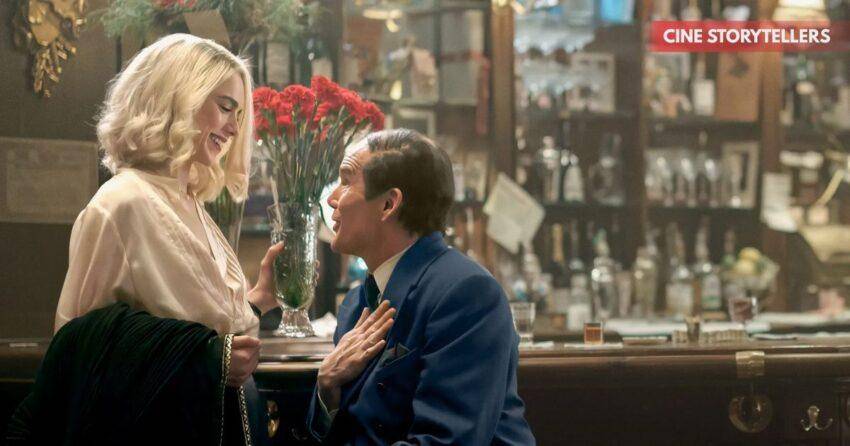Blue Moon (2025), directed by Richard Linklater, offers a compelling portrait of Broadway lyricist Lorenz Hart. Set entirely on the opening night of Oklahoma! at Sardi’s restaurant, the film captures Hart’s emotional turbulence and reflections on his legacy. Ethan Hawke delivers a deeply immersive performance, supported by a strong ensemble including Bobby Cannavale and Margaret Qualley. The film explores artistic ambition, personal struggle, and the fragility of fame, earning critical acclaim for its intimate storytelling, nuanced dialogue, and Hawke’s standout portrayal.
Introduction: A Night on Broadway
Richard Linklater’s Blue Moon takes viewers into the vibrant yet emotionally charged world of Broadway during the 1940s. Set entirely in Sardi’s restaurant on March 31, 1943, the film captures a pivotal evening in the life of Lorenz Hart (Ethan Hawke), who faces personal and professional challenges while witnessing the opening of Oklahoma!.
This confined, one-night setting allows for a concentrated focus on character development, dialogue, and emotional depth, offering audiences a rare glimpse into the psyche of a man grappling with fame, friendship, and unfulfilled aspirations.
Ethan Hawke: Mastering the Role of Lorenz Hart
Ethan Hawke delivers a performance that critics describe as transformative. Fully embodying Hart, Hawke uses subtle gestures, vocal inflections, and physical transformations—including brown contact lenses—to bring the complex lyricist to life.
“Hawke’s brilliance is in the nuance. He shows Hart’s charm and despair with equal conviction, creating a character who is both vulnerable and compelling.”
Hawke’s portrayal captures Hart’s emotional fragility, creative brilliance, and the bittersweet reality of artistic life, establishing him as the centerpiece of the film.
Richard Linklater’s Direction: Dialogue and Intimacy
Linklater’s direction emphasizes intimate storytelling and character-driven narrative. By restricting the setting to Sardi’s, the director allows dialogue, body language, and timing to drive the film’s emotional core.
The structure of Blue Moon—unfolding over a single evening—provides a unique theatricality, giving audiences the sensation of a live performance while maintaining cinematic subtlety. Linklater’s focus on timing, tension, and interaction highlights the fragility and humor of Hart’s experiences.
Supporting Cast: Depth and Chemistry
The supporting cast enriches the narrative, providing contrasting perspectives to Hart’s experiences:
- Bobby Cannavale as Eddie, the empathetic bartender, serves as Hart’s confidant, offering moments of reflection and comic relief.
- Margaret Qualley portrays Elizabeth, a Yale student whose interactions with Hart reveal his tenderness and vulnerability.
- Ensemble interactions demonstrate the tension between personal ambition and public perception, offering a microcosm of Broadway society.
The chemistry among the cast members enhances the storytelling, making Hart’s triumphs and struggles more poignant.
Themes: Art, Fame, and Fragility
Blue Moon explores themes of:
- Artistic Legacy: Hart’s awareness of his fading relevance highlights the fleeting nature of success in the entertainment industry.
- Personal Struggle: The film delves into Hart’s inner turmoil, including unfulfilled relationships and creative frustrations.
- The Human Cost of Fame: Through Hart’s lens, the audience witnesses the loneliness and pressures accompanying public success.
These themes resonate beyond Broadway, offering reflections on ambition, recognition, and the sacrifices inherent in creative pursuits.
Critical Reception: Acclaim and Analysis
Critics have praised Blue Moon for its writing, performances, and direction. Ethan Hawke’s performance is consistently highlighted as the film’s emotional anchor.
“Linklater delivers one of his finest character studies, with Hawke inhabiting Hart’s complexity in a performance that is quietly mesmerizing.” — RogerEbert.com
The film’s mix of humor, pathos, and historical context appeals to both Broadway enthusiasts and general audiences, earning a positive consensus across review platforms.
Cinematic Techniques: Visual and Emotional Storytelling
The cinematography and production design reflect the era, immersing audiences in 1940s Broadway ambiance. Close-ups, carefully framed dialogue scenes, and subtle lighting enhance emotional resonance. Linklater’s restraint in visual storytelling ensures that performances and script take center stage, maintaining intimacy and authenticity.
Sound design and period-accurate music further enrich the experience, grounding the narrative in its historical and cultural context.
Why Blue Moon Matters
Blue Moon is more than a biopic; it’s an exploration of human vulnerability and creative brilliance. By focusing on a single night in Lorenz Hart’s life, the film captures the emotional weight of artistic identity, professional rivalry, and personal isolation.
Ethan Hawke’s performance makes Hart’s struggles relatable, inviting audiences to reflect on the sacrifices and joys inherent in pursuing a creative life.
Conclusion: A Tribute to Lorenz Hart
Through meticulous performances, intimate direction, and compelling storytelling, Blue Moon stands as a poignant tribute to Lorenz Hart. The film emphasizes the fragility of fame, the importance of personal relationships, and the enduring influence of artistic contributions. Linklater’s careful craftsmanship and Hawke’s transformative portrayal ensure that the film leaves a lasting impression on audiences.
Also Read : Jessica Sanchez Stuns America’s Got Talent Judges, Earns Golden Buzzer
FAQs
Q1: What is the setting of Blue Moon?
The film takes place entirely at Sardi’s restaurant on March 31, 1943, during the opening night of Oklahoma!.
Q2: Who directed Blue Moon?
Richard Linklater directed the film, known for his character-driven narratives and innovative storytelling.
Q3: Who plays Lorenz Hart in the film?
Ethan Hawke portrays Lorenz Hart, delivering a nuanced and critically acclaimed performance.
Q4: What themes does the film explore?
Blue Moon explores artistic legacy, personal struggles, the cost of fame, and the intricacies of creative life.
Q5: How has the film been received by critics?
The film has received widespread acclaim for its performances, writing, and direction, particularly Hawke’s immersive portrayal of Hart.
Q6: Who are key supporting actors in the film?
Bobby Cannavale and Margaret Qualley provide pivotal support, enriching the narrative with depth and emotional resonance.
Q7: Where can audiences watch Blue Moon?
Blue Moon premiered at the Berlin Film Festival and will release in U.S. theaters in October 2025, with subsequent wider distribution planned.
Join our WhatsApp channel for more updates and information about celebrities and entertainment
Discover more from Cine Storytellers
Subscribe to get the latest posts sent to your email.
